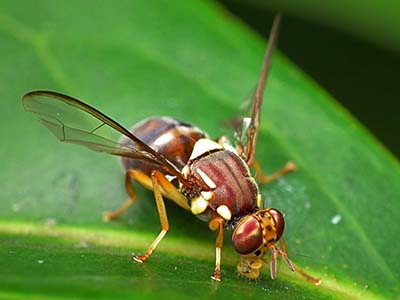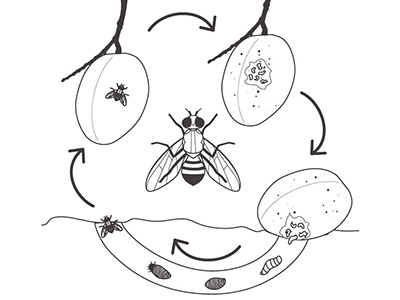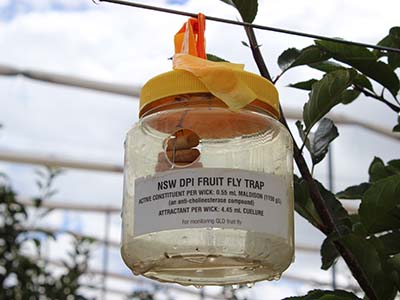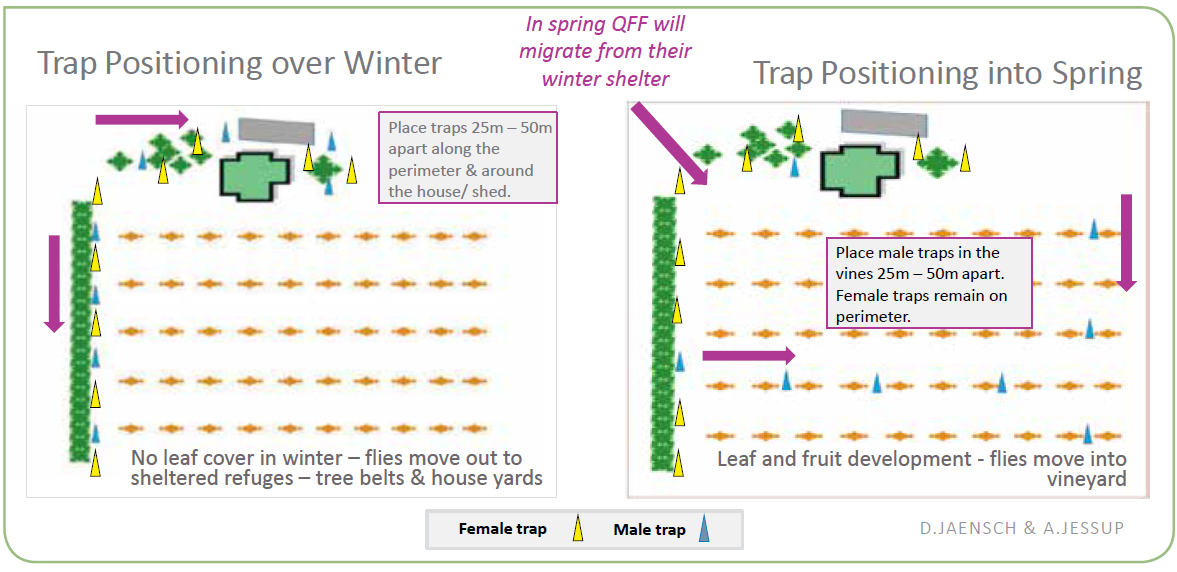Fruit fly – prevention is key for growers
29 January 2019
This article, originally published in The Vine, provides a thorough overview of the range of Queensland fruit fly control methods and strategies available to grape growers.

For table grape growers, fruit fly is one of the major pests of concern for both the domestic and export markets. Chemical restrictions and regulation changes over the years have resulted in the withdrawal of many commonly used chemicals, with growers looking for effective alternative control options on-farm.
While we may not like to hear it, a single fruit fly anywhere in Australia costs the industry both financially and by reputation as a producer of clean, green produce.
In Australia there are hundreds of fruit fly species; however only two main species are considered to cause the greatest economic threats – Mediterranean fruit fly (Ceratitis capitata) and Queensland fruit fly (Bactrocera tryoni).
Mediterranean fruit fly occurs only in the west (in parts of Western Australia) but outbreaks and detections have been found in South Australia in previous years.
Queensland fruit fly (Qfly) is native to Australia and inhabits eastern Australia, throughout parts of the Northern Territory, Queensland, New South Wales and Victoria. Qfly has the ability to quickly become an endemic threat to Australian fresh producers not only because of its large geographic spread, but due to its ability to survive and thrive under a range of temperatures and conditions.
While Qfly will survive in several geographical areas, a single Qfly is only mobile over relatively short distances, moving from vineyard to vineyard, or from native (or urban hosts) into commercial production areas.
It thrives because it is able to lay its eggs in a wide range of host plants, so it can spread rapidly and establish over large areas if the conditions are suitable. This combination of rapid breeding and adaptability is what makes management of Qfly so difficult and why it is considered a serious insect pest of Australian horticulture.
This article focuses on Qfly – how to monitor and put in place measures that prevent a build-up in the population on-farm. Armed with this practical advice growers can plan, schedule and react, as they do for any other pests or disease. To better understand how to do this, it helps to know more about the fly.
Extensive host range
Over 100 fruit and vegetables are confirmed hosts of Qfly meaning more than three quarters of Australian fruit and vegetable exports are susceptible to infestation.
Qfly could be present not only on your property, but also on your neighbours’. Residential gardens, home orchards and wind breaks such as olives, can also contain host plants for Qfly to complete their life-cycle. Therefore, even with appropriate vineyard management, there could be Qfly living near your commercial vineyard that could fly into your crop when fruit begins to ripen.
Production losses in endemic areas are estimated to range from 0.5% to 3% annually (figures available from Fruit Fly Fund, Hort Frontiers projects) using current management techniques. Without any management, production losses due to Qfly will be significantly higher.
The adult Qfly
Mature Qfly can be up to 8 millimetres long, with a red to dark brown body. The Qfly has a narrow waist between the thorax (mid-section of the Qfly) and the abdomen, and the thorax is patterned with cream to yellow shoulder markings and stripes. The wings are transparent. The female can be identified by the ovipositor (or ‘stinger’) at the base.
An adult Qfly can live for several months, depending on environmental conditions and food availability.
Adult Qfly can live throughout Winter and become active again in Winter/early Spring as temperatures increase. Protein and sugar sources are required for sexual maturation (the process of becoming mature), and egg maturation after mating. Flies can occasionally be seen moving around plants early in the morning looking for protein, then rest during the hottest part of the day within leafy canopies. Mating occurs at dusk and female Qfly may mate once, or many times; they are more likely to re-mate if they sensed their first mate lacked fitness.
The life cycle of Qfly
Approximately two days after mating, the adult female can lay several dozen eggs into maturing fruit still on the vine. The eggs hatch inside the fruit and the larva feed on the ripening fruit. A single adult female can lay up to two thousand eggs in one life-time.

In some horticultural production regions, Qfly could have up to five generations a year because the lifecycle may be as short as three weeks. This is why multiple control measures are recommended to target the different stages – eggs, larvae, pupae and adult Qfly.
Table grape growers can be proactive by monitoring and controlling Qfly within their vineyard. However, if you can work with neighbours, e.g. by sharing monitoring results, each grower will benefit from knowing when and where the Qfly are increasing in number, making control methods most effective.
Monitoring – knowledge is power
Monitoring Qfly on your property shows you whether Qfly populations are increasing or decreasing over time. Traps provide an indicator of Qfly presence and tell you when to act.
The following steps describe how you can install a monitoring system to track trends in Qfly numbers and determine if control measures are adequate.
1. Monitor using traps

Install traps in your vineyard (Figure 1). There are several commercial traps available. Most traps have a plastic pot containing a lure to attract the Qfly plus a toxicant that kills flies once they enter the trap.
Traps generally require servicing every three months (i.e. clean, recharge with new lures/ pesticides). Follow label instructions.
In the vineyard, traps used for monitoring target the male fly population. Male lures can attract and trap male Qfly from up to 200 metres, which is more economical than using female traps (female traps generally attract flies from only about 10 to 15 meters).
Male traps should be installed at a rate of five traps per hectare, or 25 to 50 metres apart in both directions (along the vine row and across the vine rows).
On the perimeter of the vineyard, or around the house/sheds, female traps can be used to draw flies out of the vineyard, and to intercept new females coming in (Figure 1).
2. When to start monitoring
Traps should be installed well before véraison i.e. six to eight weeks before the harvest date and checked weekly until two to three weeks after harvest to detect any Qfly that remain after the crop has been harvested.
Make a trapping schedule by back- dating six to eight weeks before the approximate harvest date for each grape variety. Remember that harvest timing varies depending on location, season and management practice.
3. Where to place the trap

To ensure good placement, think about where Qfly is most likely to enter the property. You may need to look beyond the vineyard.
Look nearby for: rogue fruit trees; house gardens; native vegetation or evergreens; animal pens (e.g. chickens, pigs, horses etc.); fertiliser stores; packing sheds and fruit disposal areas; earlier ripening grape varieties. These are areas where the flies will be resting, feeding and drinking.
Traps can be moved from the early varieties to the late season varieties if this can be done well before late season véraison.
In Winter, move traps to the edge of the vineyard as the flies will typically move out of the vines during leaf drop. Qfly will migrate to warmer and more sheltered places such as evergreen trees, windbreaks, house gardens and buildings so that they can survive over the Winter. A lemon tree is a good spot for a Winter trap. Store surplus traps out of the sun so the plastic lasts longer.
4. When to check the traps
Check traps at least once a week, starting before véraison through to the end of picking. Remove the dead flies as they are counted and record the number for each trap. One Qfly is the trigger to start bait-spraying or other control measures.
When checking traps, cut open several berries to continually check for larvae. When female Qfly are pregnant they are more interested in laying eggs in fruit than feeding, and they might fly bypass the trap.
In Winter and Spring, check traps every second week as the adult Qfly will come out from their shelter on a sunny day to start feeding. This is when protein-based female traps are most effective.
5. When to act
When a single Qfly is found in a monitoring trap, there will be more than one Qfly in the vineyard. Immediate action is required so be ready to start control on the same day.
Tips for success
- Start monitoring well before véraison (i.e. 6 to 8 weeks before harvest).
- Place monitoring traps within the shade of the canopy, avoiding direct sun or areas that get very hot.
- Place traps at about 1.5 to 2 metres high.
- Replace lures and toxicants as recommended (typically every 3 to 4 months).
- Use a network of traps, not just one.
- Check traps weekly in Summer and Autumn and fortnightly in Winter and Spring.
- Empty the flies from the trap and record numbers for each trap.[/gdlr_styled_box]
Bait sprays
Bait sprays are a preventative spray that attracts and kills both male and female Qfly before they build up in high numbers. Bait sprays target hungry juvenile Qfly which need protein as a food source to mature sexually and to keep laying more eggs.
How does it work? The bait spray mixes a liquid protein, which attracts the Qfly, with an insecticide which kills the Qfly. Female flies are especially attracted to the protein during egg development. When the Qfly feeds on the protein mixed with insecticide, they die. Bait sprays are more effective when applied early in the morning when the flies are likely to feed.
How is it applied? In vineyards, spot- spray the upper part of a trellis post in the shade of the canopy or spray a continuous stream within the canopy. Avoid spraying the fruit to prevent any residue concerns and damage.
Spray each vine in every second row one week and alternate rows the following week. At the same time, spot spraying in the non-vineyard area will target potential sources of re- infestation.
The attract-and-kill activity of bait sprays is generally short-lived and a fresh batch is recommended for weekly applications. Adding a thickening agent (e.g. Xantham gum) helps the spray last longer, however Xantham gum needs to be prepared the night before to ensure a smooth consistency when added to the bait and insecticide. Be prepared to make some adjustments to the spray set-up (e.g. coarser nozzles) if using a thickening agent to ensure successful application. Additional applications may be required if monitoring traps continue to catch Qfly, or if rain falls within three days of application.
Best results are achieved when bait sprays commence early in the season, aligning with the first emergence of Qfly in August, and re-applied weekly until three weeks after harvest. In areas with high numbers, it may take several bait sprays before the numbers reduce to low levels.
Follow the recommendations on the label and record any sprays. Contact the Australian Pesticides and Veterinary Medicines Authority (APVMA), your local agriculture department or chemical supply store for chemical advice.
IMPORTANT! – Optimum results are achieved when bait sprays are used together with other control strategies that target different stages of the lifecycle.
Tips for success
- With Qfly, prevention is better than cure.
- Start applying bait sprays well before véraison and continue for two to three weeks after harvest.
- Spot or strip-spray every second row over the entire block and surrounds.
- Avoid applying on the ground or directly onto the fruit.
- Persistence is key – set a ‘spray day’ for weekly applications and reapply after hot weather or rain, spraying vine canopies early in the morning.[/gdlr_styled_box]
Male Annihilation Technique
Male Annihilation Technique (MAT) – means using an ‘attract and kill’ strategy for male Qfly. While the male doesn’t damage the fruit, reducing the number of males will reduce the opportunity for mating, which reduces the size of the population in the long term. Getting rid of males should be used together with other control measures.
How does it work? There are several MAT devices (MATs) commercially available in the form of ‘stations’, ‘wafers’, ‘cups’ or ‘wicks’. MATs contain an insecticide lure that attracts the male Qfly, which feed on the lure and then die. While bait spraying is also a form of MAT, the term MAT usually refers to the device that targets male flies.
How are they applied? MAT devices are usually placed throughout the vineyard at a density of up to 20 per hectare, starting at véraison through to Autumn. MATs can also be used around the vineyard boundary to reduce the number of male Qfly entering the property or block.
MAT devices typically need replacing every 3 to 4 months. Check the label requirements. If traps are catching flies in Winter, MAT may be useful throughout the year. Some growers pre-order their MAT devices (see below) 12 months ahead so they arrive every three months ready to replace the old ones.
NOTE: If you plan to export, or are located in a pest-free-area, please check if there are any limits to the use of in-field MAT. Contact your State Government department for more information.
Tip for success
When first installing MATs, pre-order their replacement to arrive in three months’ time.[/gdlr_styled_box]
Good on-farm hygiene practices
Like washing your hands before eating, good hygiene practices in your vineyard are essential to reducing the risk of infestation by pests and disease infection. Vineyard hygiene means all vineyards and surrounds (e.g. house gardens and other non-crop areas such as windbreaks, and sheds etc.) need to be kept clean and free from fruit that might be harbouring Qfly.
Vineyard hygiene reduces Qfly’s ability to live and reproduce and is critical in preventing Qfly becoming established in the vineyard.
How does it work? Hygiene works by removing all possible places that the Qfly can complete its life cycle (additional to controls applied to your commercial crop of course). Pick all bunches left on the vine after harvest, and pick up, or treat, any berries that have dropped to the ground.
If bunches are cleaned and packed in the field, treat the waste-fruit on the ground by spraying with a herbicide to hasten the breakdown of berries or slashing. Treatment within 24 hours will help to reduce the chance of larvae entering the soil.
Fruit from packhouses also needs to be disposed of appropriately by treating, spraying, macerating or deep burial (cover fruit with at least 50 centimetres of soil on a daily basis). Contact your local council or state department for further advice.
Removing any unwanted, neglected or rogue hosts (fruit or vegetables) around the house block, pickers huts or sheds, channels, creeks and roadsides is also crucial, as these are potential breeding sites for Qfly.
If you have wind breaks, or other trees in, or near the vineyard, that are Qfly hosts, apply control bait spray or cover spray at the same time that you spray the commercial crop. Keep these trees to a manageable height and pick all the fruit early, or as they ripen, so that fruit is not left to over-ripen or drop to the ground.
Keeping the inter-row vegetation or cover-crop low will also help reduce potential Qfly overwintering within the vineyard.
Ask visiting family and friends not to bring fresh fruit on to your property… ask them to bring a jar of jam instead!
Tips for success
- Remove, treat or destroy all noncommercial fruit that may be harbouring Qfly.
- Keep cover-crops managed over winter.
The information in this article was provided by the Greater Sunraysia Pest Free Area and the Hort Frontiers Fruit Fly Fund.